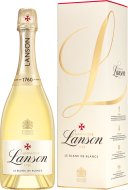Chateau Lafon Rochet
Albert Lebrun Champagne Brut Non-Vintage Grand Cru
Founded in 1860 by Leon Lebrun in Avize , in the heart of the " Côtes des Blancs". His son Albert , gave his final name to the house which has upheld a wonderful tradition for more than 135 years. Since 2003, House of Champagne Albert Lebrun is part of the Rapeneau family business, which has become one of the largest independent growers in the Champagne Region. TERROIR Grands Crus villages :Côte des Blancs BLEND: 100% Chardonnay DOSAGE 10g / L TASTING NOTES: A pale yellow color. An elegant and delicate nose with white fruit (peach) and citrus fruit notes. Lively and fresh on the palate combining acidity and minerality.
Vie di Romans Chardonnay
Domaine du Pelican Arbois Chardonnay
Lanson Blanc de Blancs Champagne
Lanson Blanc de Blancs Champagne was created by winemaker Herve Dantan, when he joined the Lanson House back in 2013. It combines the freshness style of Lanson champagnes with the delicacy of the Chardonnay. The grapes come from the best Chardonnay crus in Champagne including Oger, Cramant, Le Mesnil-sur-Oger, and Vertux. It is made with 40% reserve wines from Grands and Premiers Crus matured in Oak Cask and gets aged for 5 years in the Lanson House cellars before getting released.Lanson Blanc de Blancs is a gold luminous champagne with fine and lively bubbles. The nose reveal aromas of fine pastry, frangipane notes, candied citrus and fresh pear. On the palate this champagne is precise and generous, with flavours of candied lemon, almond, nougat and honey and a long finish.
Domaine Weinbach Alsace Théo Riesling
At the foot of the majestic Schlossberg hill, in a setting of vines and roses, the Domaine Weinbach "wine stream", named after the small stream that crosses it, was built in 1612 by the Capuchin monks. Sold as national property during the French Revolution, the Estate was acquired in 1898 by the Faller brothers who passed it on to their son and nephew Théo. A great figure in the Alsatian vineyard and ardent promoter of its recognition as an Appellation d'Origine Contrôlée, Théo Faller works for the quality of Alsace wines and the development of their incomparable terroirs and grape varieties. In love with his property, he develops it, enlarges it and embellishes it. From 1979, his wife Colette and his daughters Catherine and Laurence demonstrated the same passion for the great wines of Alsace and the same unfailing attachment to quality. Since 2016, Catherine Faller has been running the Domaine with her sons Eddy and Théo. Cuvée Théo Riesling comes exclusively from the monopole Le Clos des Capucins. The clos is well protected from winds by the surrounding hills and by the walls that enclose it. The soils consist of sand, alluvial pebbles and granitic gravel. Here, the low-cropping vines typically offer up a supple and pithy Riesling that is beautifully accessible when young - a reflection of these sandy soils. As per all Weinbach dry Rieslings, this was whole-bunch pressed, fermented without any yeast additions and matured in very old oak casks for 10 months. Biodynamic. It’s beautifully ripe yet crisp, with flawless clarity and vibrating citric freshness. Expect waves of crunchy citrus pith, florals and stone-fruit juiciness, excellent pulp and precision and driven compact length. Finishing on a mineral/umami note, this is a brilliant Riesling—arguably the most electric young Théo Riesling we have seen for some time. All class. Beautifully ripe yet crisp, with flawless clarity and vibrating citric freshness. Expect waves of crunchy citrus pith, florals and stone-fruit juiciness, excellent pulp and precision and driven compact length. Finishing on a mineral/umami note, this is a brilliant Riesling.









